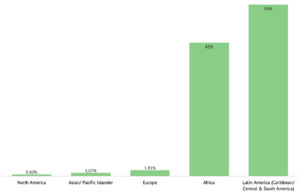Hidden in Plain Sight: Black Immigrants and the Organizations Working to Welcome and Support Them
Black History month is a time to reflect on and appreciate Black history, culture, and people. In 1619, the first enslaved Africans were kidnapped and brought to this land. Since then, the Black population of the United States has grown to 47 million people.
Although Black immigrants are often overlooked in national discussions about immigration, they are integral to the prosperity of our economy and the vibrancy of our communities. Black people, US-Born and immigrants, make up 14 percent of the total US population.
One in Ten Immigrants Is Black (10.4 Percent)
| Total US Population | Black or African American | Share of Population Identifying as Black or African American | |
| US Born | 284,711,561 | 42,366,826 | 14.9% |
| Immigrants | 45,013,922 | 4,664,030 | 10.4% |
| Total | 329,725,483 | 47,030,856 | 14.3% |
Fig 1. Immigration Research Initiative analysis of 2021 ACS 5-year data. The column for Black or African American includes people who identify as Black/African American alone or in combination with one or more other races. US Born includes US citizens born in Puerto Rico or US Island Areas and those born abroad of American parent(s).
…And, One in Ten Black Americans Is an Immigrant (9.9 Percent)
| Estimate | Share | |
| US Born Black or African American | 42,366,826 | 90.1% |
| Immigrants who are Black | 4,664,030 | 9.9% |
| Total Black or African American | 47,030,856 | 100% |
Fig 2. Immigration Research Initiative analysis of 2021 ACS 5-year data. The column for Black or African American includes people who identify as Black/African American alone or in combination with one or more other races. US Born includes U.S. citizens born in Puerto Rico or U.S. Island Areas and those born abroad of American parent(s).
Of the 45 million immigrants in the United States, 4.7 million (10.4 percent) are Black. And of the 47 million Black people who live in the United States, 4.7 million (9.9 percent) are immigrants.
Black people from all over the globe have immigrated to the United States. A bit more than half of Black immigrants come from the Caribbean/ Latin America (54 percent), and a bit under half from Africa (42 percent), with almost all the remaining 4 percent being represented by Black Europeans and Asian/Pacific Islanders.
About Half of Black Immigrants Are from Latin America and a Little Less than Half Are from Africa
Fig 3. Immigration Research Initiative analysis of 2021 ACS 5-year data. Census data include Mexico in Central America.
Top Countries of Origin for Black Immigrants in the US
| Estimate | Share | ||
| 1 | Jamaica | 759,356 | 16% |
| 2 | Haiti | 672,565 | 14% |
| 3 | Nigeria | 391,195 | 8% |
| 4 | Ethiopia | 262,550 | 6% |
| 5 | Dominican Republic | 206,716 | 4% |
| 6 | Ghana | 186,244 | 4% |
| 7 | Trinidad and Tobago | 184,767 | 4% |
| 8 | Guyana | 135,059 | 3% |
| 9 | Kenya | 134,270 | 3% |
| 10 | Somalia | 98,741 | 2% |
| All Other Countries | 1,632,539 | 35% | |
| Total | 4,664,002 | 100% |
Fig 4. Immigration Research Initiative analysis of 2021 ACS 5-year data.
Black immigrants in the US come from 141 different countries. The top five countries of origin represent about half, 49 percent, of Black immigrants in the United States. No one country representing more than 16 percent of the total, with immigrants from a large number of countries with less than 100,000 immigrants each making up a third of the total.
There are many groups that are rooted in the Black community that focus on Immigration issues and advocacy. Some work nationally, others are rooted in specific local communities. Their work is crucial to welcoming and supporting the newest Black Americans to their communities around the country. There are many organizations working at the intersection of Black Immigration and Black U.S.-born communities—this list is just a start.
We are pleased to share, uplift, and celebrate this important work of these groups, and welcome suggestions for additions to the list:
- African Bureau for Immigration and Social Affairs (ABISA)
- African Bridge Network
-
- Read more about their work in Harlem in this article,
- AfroResistance
- Black Migrant Power Fund
- Black Immigrants Bail Fund
- Louisiana Organization for Refugees and Immigrants (LORI)
- Mauritanian Network for Human Rights in USA
- Refugee and Immigrant Center for Education and Legal Services (RAICES)
- RAICES collaborated with BAJI to write this report,
- The Partnership for the Advancement of New Americans (PANA)
By Shamier Settle, Senior Policy Analyst
